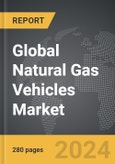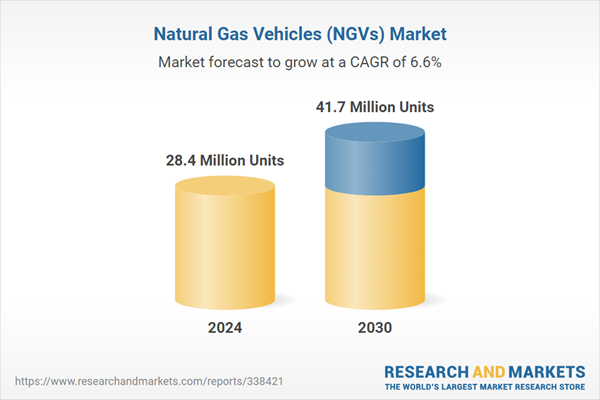The global market for Natural Gas Vehicles (NGVs) was sized at 28.4 Million Units in 2024 and is projected to reach 41.7 Million Units by 2030, growing at a CAGR of 6.6% from 2024 to 2030. This comprehensive report provides an in-depth analysis of market trends, drivers, and forecasts, helping you make informed business decisions. The report includes the most recent global tariff developments and how they impact the Natural Gas Vehicles (NGVs) market.
Technological advancements have significantly improved the performance and viability of NGVs. Modern engines designed for natural gas combustion are highly efficient and offer comparable power and torque to traditional internal combustion engines. Advances in storage technology have increased the range of NGVs, addressing one of the main concerns related to their practicality for long-distance travel. Additionally, the development of a more extensive refueling infrastructure has made it easier for NGV owners to access CNG and LNG, further supporting the adoption of these vehicles. Innovations in onboard diagnostics and vehicle telematics are also enhancing the operational efficiency of NGVs, allowing fleet managers to monitor fuel consumption and maintenance needs in real-time. These technological improvements have contributed to the growing acceptance of NGVs in both the commercial and private sectors.
The growth in the natural gas vehicles market is driven by several factors, including technological innovations, regulatory policies, and economic incentives. Governments around the world are implementing stringent emissions regulations and offering subsidies to encourage the adoption of cleaner vehicle technologies, including NGVs. These regulatory measures are particularly influential in sectors such as public transportation and freight, where reducing emissions is a priority. Additionally, the lower cost of natural gas compared to gasoline and diesel provides a significant economic incentive for businesses and consumers to switch to NGVs. The rising awareness of environmental issues and the increasing demand for sustainable transportation solutions are also key drivers. Furthermore, the development of a more robust refueling infrastructure, with more CNG and LNG stations being established globally, is making it more convenient for NGV owners to refuel, thus boosting market growth. The combined effect of these factors is creating a favorable environment for the expansion of the NGV market, promising a cleaner and more sustainable future for the transportation industry.
Segments: Vehicle Type (Light Duty Vehicles, Medium & Heavy Duty Trucks, Medium & Heavy Duty Buses).
Geographic Regions/Countries: World; USA; Canada; Japan; China; Europe; France; Germany; Italy; UK; Spain; Russia; Rest of Europe; Asia-Pacific; Australia; India; South Korea; Rest of Asia-Pacific; Latin America; Argentina; Brazil; Mexico; Rest of Latin America; Middle East; Iran; Israel; Saudi Arabia; UAE; Rest of Middle East; Africa.
The analysts continuously track trade developments worldwide, drawing insights from leading global economists and over 200 industry and policy institutions, including think tanks, trade organizations, and national economic advisory bodies. This intelligence is integrated into forecasting models to provide timely, data-driven analysis of emerging risks and opportunities.
Global Natural Gas Vehicles (NGVs) Market - Key Trends & Drivers Summarized
Natural Gas Vehicles (NGVs) are an increasingly important segment of the transportation industry, offering a cleaner alternative to traditional gasoline and diesel-powered vehicles. NGVs operate using compressed natural gas (CNG) or liquefied natural gas (LNG), both of which produce significantly lower levels of harmful emissions such as carbon dioxide (CO2), nitrogen oxides (NOx), and particulate matter. This makes NGVs an attractive option for reducing the environmental impact of transportation, particularly in urban areas where air quality is a major concern. These vehicles are used in a variety of applications, including public transit buses, commercial delivery trucks, and passenger cars. Governments and private companies alike are investing in NGVs as part of broader efforts to transition to more sustainable energy sources and reduce reliance on fossil fuels.Technological advancements have significantly improved the performance and viability of NGVs. Modern engines designed for natural gas combustion are highly efficient and offer comparable power and torque to traditional internal combustion engines. Advances in storage technology have increased the range of NGVs, addressing one of the main concerns related to their practicality for long-distance travel. Additionally, the development of a more extensive refueling infrastructure has made it easier for NGV owners to access CNG and LNG, further supporting the adoption of these vehicles. Innovations in onboard diagnostics and vehicle telematics are also enhancing the operational efficiency of NGVs, allowing fleet managers to monitor fuel consumption and maintenance needs in real-time. These technological improvements have contributed to the growing acceptance of NGVs in both the commercial and private sectors.
The growth in the natural gas vehicles market is driven by several factors, including technological innovations, regulatory policies, and economic incentives. Governments around the world are implementing stringent emissions regulations and offering subsidies to encourage the adoption of cleaner vehicle technologies, including NGVs. These regulatory measures are particularly influential in sectors such as public transportation and freight, where reducing emissions is a priority. Additionally, the lower cost of natural gas compared to gasoline and diesel provides a significant economic incentive for businesses and consumers to switch to NGVs. The rising awareness of environmental issues and the increasing demand for sustainable transportation solutions are also key drivers. Furthermore, the development of a more robust refueling infrastructure, with more CNG and LNG stations being established globally, is making it more convenient for NGV owners to refuel, thus boosting market growth. The combined effect of these factors is creating a favorable environment for the expansion of the NGV market, promising a cleaner and more sustainable future for the transportation industry.
Report Scope
The report analyzes the Natural Gas Vehicles (NGVs) market, presented in terms of units. The analysis covers the key segments and geographic regions outlined below.Segments: Vehicle Type (Light Duty Vehicles, Medium & Heavy Duty Trucks, Medium & Heavy Duty Buses).
Geographic Regions/Countries: World; USA; Canada; Japan; China; Europe; France; Germany; Italy; UK; Spain; Russia; Rest of Europe; Asia-Pacific; Australia; India; South Korea; Rest of Asia-Pacific; Latin America; Argentina; Brazil; Mexico; Rest of Latin America; Middle East; Iran; Israel; Saudi Arabia; UAE; Rest of Middle East; Africa.
Key Insights:
- Market Growth: Understand the significant growth trajectory of the Light Duty Vehicles segment, which is expected to reach 38.4 Million Units by 2030 with a CAGR of a 6.7%. The Medium & Heavy Duty Trucks segment is also set to grow at 6.0% CAGR over the analysis period.
- Regional Analysis: Gain insights into the U.S. market, sized at 189.6 Thousand Units in 2024, and China, forecasted to grow at an impressive 7.3% CAGR to reach 9.7 Million Units by 2030. Discover growth trends in other key regions, including Japan, Canada, Germany, and the Asia-Pacific.
Why You Should Buy This Report:
- Detailed Market Analysis: Access a thorough analysis of the Global Natural Gas Vehicles (NGVs) Market, covering all major geographic regions and market segments.
- Competitive Insights: Get an overview of the competitive landscape, including the market presence of major players across different geographies.
- Future Trends and Drivers: Understand the key trends and drivers shaping the future of the Global Natural Gas Vehicles (NGVs) Market.
- Actionable Insights: Benefit from actionable insights that can help you identify new revenue opportunities and make strategic business decisions.
Key Questions Answered:
- How is the Global Natural Gas Vehicles (NGVs) Market expected to evolve by 2030?
- What are the main drivers and restraints affecting the market?
- Which market segments will grow the most over the forecast period?
- How will market shares for different regions and segments change by 2030?
- Who are the leading players in the market, and what are their prospects?
Report Features:
- Comprehensive Market Data: Independent analysis of annual sales and market forecasts in US$ Million from 2024 to 2030.
- In-Depth Regional Analysis: Detailed insights into key markets, including the U.S., China, Japan, Canada, Europe, Asia-Pacific, Latin America, Middle East, and Africa.
- Company Profiles: Coverage of players such as Daimler AG, Honda Motor Co., Ltd., Bayerische Motoren Werke AG (BMW GROUP), AB Volvo, Adam Opel AG and more.
- Complimentary Updates: Receive free report updates for one year to keep you informed of the latest market developments.
Some of the 55 companies featured in this Natural Gas Vehicles (NGVs) market report include:
- Daimler AG
- Honda Motor Co., Ltd.
- Bayerische Motoren Werke AG (BMW GROUP)
- AB Volvo
- Adam Opel AG
- Blue Bird Corporation
- Bajaj Auto Ltd.
- Iveco SpA
- Jiangling Motors Co., Ltd.
- Champion Bus, Inc.
- Freightliner Trucks
- Hyundai Motor Company
- Alexander Dennis Ltd.
- Autocar LLC
- GILLIG LLC
Tariff Impact Analysis: Key Insights for 2025
Global tariff negotiations across 180+ countries are reshaping supply chains, costs, and competitiveness. This report reflects the latest developments as of April 2025 and incorporates forward-looking insights into the market outlook.The analysts continuously track trade developments worldwide, drawing insights from leading global economists and over 200 industry and policy institutions, including think tanks, trade organizations, and national economic advisory bodies. This intelligence is integrated into forecasting models to provide timely, data-driven analysis of emerging risks and opportunities.
What’s Included in This Edition:
- Tariff-adjusted market forecasts by region and segment
- Analysis of cost and supply chain implications by sourcing and trade exposure
- Strategic insights into geographic shifts
Buyers receive a free July 2025 update with:
- Finalized tariff impacts and new trade agreement effects
- Updated projections reflecting global sourcing and cost shifts
- Expanded country-specific coverage across the industry
Table of Contents
I. METHODOLOGYII. EXECUTIVE SUMMARY2. FOCUS ON SELECT PLAYERSIII. MARKET ANALYSISIV. COMPETITION
1. MARKET OVERVIEW
3. MARKET TRENDS & DRIVERS
4. GLOBAL MARKET PERSPECTIVE
UNITED STATES
CANADA
JAPAN
CHINA
EUROPE
FRANCE
GERMANY
ITALY
RUSSIA
REST OF EUROPE
ASIA-PACIFIC
INDIA
PAKISTAN
THAILAND
UZBEKISTAN
REST OF ASIA-PACIFIC
LATIN AMERICA
ARGENTINA
BRAZIL
REST OF LATIN AMERICA
MIDDLE EAST
IRAN
REST OF MIDDLE EAST
AFRICA
Companies Mentioned (Partial List)
A selection of companies mentioned in this report includes, but is not limited to:
- Daimler AG
- Honda Motor Co., Ltd.
- Bayerische Motoren Werke AG (BMW GROUP)
- AB Volvo
- Adam Opel AG
- Blue Bird Corporation
- Bajaj Auto Ltd.
- Iveco SpA
- Jiangling Motors Co., Ltd.
- Champion Bus, Inc.
- Freightliner Trucks
- Hyundai Motor Company
- Alexander Dennis Ltd.
- Autocar LLC
- GILLIG LLC
Table Information
| Report Attribute | Details |
|---|---|
| No. of Pages | 280 |
| Published | April 2025 |
| Forecast Period | 2024 - 2030 |
| Estimated Market Value in 2024 | 28.4 Million Units |
| Forecasted Market Value by 2030 | 41.7 Million Units |
| Compound Annual Growth Rate | 6.6% |
| Regions Covered | Global |









